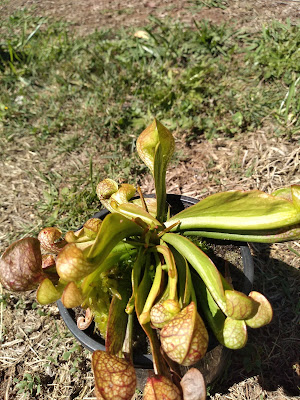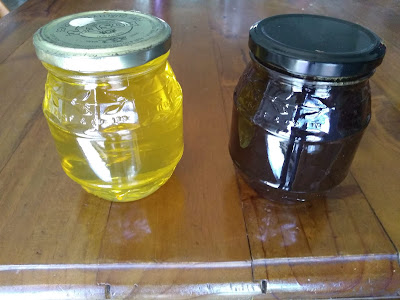Late last winter or early spring a very generous person sent me a small plant of Sarracenia psittacina (golf ball form). I believe he imported seeds and grew this plant from them.
Sarracenia psittacina is a lovely looking plant, and I have read about the golf ball form. The few pictures I had seen had large round heads on the pitchers and brilliant colouration. The few descriptions I had read made it sound like a strong growing plant.
It is a really nice looking plant, my photos do not do it justice. As I type this I realise that it is now quite a lot larger than it was in any of these photos, I haven't got around to take any more recent pictures.
 |
| Look so much larger once repotted |
When it arrived, the plant was small, but looked very healthy. It also had a seedling of what appears to be a hybrid Sarracenia tucked under it.
I didn't want to damage either plant so I left them together to grow larger before attempting to divide them.
 |
| The plants not long after they arrived |
As I planted them I snapped one of the young pitchers. You can see it in the photo above. Not a great start, but the plant seemed to forgive me for this and started growing pretty much straight away.
As the plants grew, the psittacina grew faster and larger than the hybrid. It got so large that I forgot that I still had the little hybrid. If you look closely below you can still see it in the pot.
 |
| It grew quickly |
Before I knew it my plant needed a larger pot. I kept saying to myself that I would repot it later, and I kept putting it off. It didn't take long for the plant to be far too large for its tiny pot.
 |
| Needed repotting and dividing |
It looks a bit silly having such a large plant in such a tiny pot. It probably would have grown even faster had it been in a larger pot earlier.
 |
| This needed to go into a larger pot |
It is amazing how much larger plants look once they are in a decent sized pot.
I separated the two plants and put the hybrid in its own little pot. The tiny hybrid still looks healthy enough.
 |
| repotted and divided |
I really like Sarracenia psitticina golf ball form. I hope I can over winter it successfully and see just how large it will grow next year.



















































